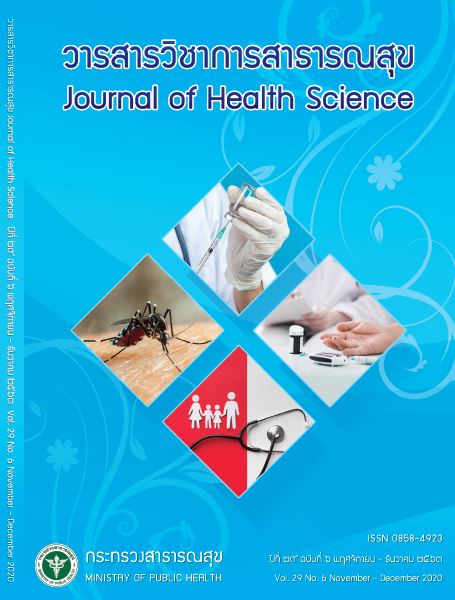Diabetes Surveillance: Analysis of Thai Behavioral Risk Factor Surveillance System in 2018
Keywords:
diabetes, Thai behavioral risk factor surveillance survey (BRFSS), risk behavior, noncommunicable disease, injuryAbstract
Thailand is facing an increase of chronic non-communicable diseases. The burden of diabetes and its complications impose a massive overload on health care system. Thai Behavioral Risk Factor Surveillance System (Thai BRFSS) has been implemented as a strategy for non-communicable diseases prevention and control. Population-based sample surveys are commonly used to assess the magnitude of risk factors, morbidity and the quality of health care. This study aimed to monitor diabetes situation and evaluate the effectiveness of diabetes care programs. Altogether 44,171 samples were selected using stratified two-stage cluster sampling technique from urban and rural areas in 21 provinces across the whole country including Bangkok. Data collection was performed through face to face interview using questionnaires. The estimated prevalence was analyzed with population weight using SAS version 9.4. It was found that approximately 55.2% of the samples aged 15-79 years had blood screening for diabetes in the last year, and 9.8% were told by doctor that they had diabetes. The prevalence was higher in female (11.1% compared to 8.0% for male). Majotiry of diabetis patients (36.4%) visited health care services three to four times a year, followed by over 6 times a year (24.1%), and once or twice a year (9.0%). Around 9.9% of the patients had never visited health care facility in the last year. Among diabetes patients, 92.7% had known their blood sugar level; and diabetes control was via oral medicine (77.2%) and insulin injection (17.4%). Annual checking for fundus ophthalmology was reported in 63.7% and foot examination for early diagnosis and prevent complications in 69.4% of cases. The results of this study implied that annually around 29.5 million people in Thailand were screened for diabetes; and 3.3 million were informed on there disease status. In addition, majority of the patients did not have proper care for the disease. Thus, preventive and curative strategics are urgently needed to control the situation. These include the strengthening of professional and public education for diabetes program and implementation of effective control approaches to reduce diabetes burden. In addition, proper self-management should be widely promoted as an effective approach for the improvement of health of people with diabetes.
Downloads
References
World Health Organization. Global report on diabetes. Geneva: World Health Organization; 2016.
GBD 2015 Risk Factors Collaborators. Global, regional, and national comparative risk assessment of 79 behavioural, environmental and occupational, and metabolic risks or clusters of risks, 1990–2015: a systematic analysis for the global burden of disease study 2015. Lancet 2016;388(10053):1659–724
NCD Risk Factor Collaboration. Worldwide trends in diabetes since 1980: a pooled analysis of population-based studies with 4· 4 million participants. Lancet 2016;387(10027):1513–30.
วิชัย เอกพลากร, บรรณาธิการ. รายงานการสำรวจสุขภาพ ประชาชนโดยการตรวจร่างกายครั้งที 5 พ.ศ. 2557, นนทบุรี: ่ สถาบันวิจัยระบบสาธารณสุข; 2559.
World Health Organization. Global action plan for the prevention and control of Noncommunicable diseases 2013-2020. Geneva: World Health Organization; 2013.
กมลทิพย์ วิจิตรสุนทรกุล. การสำรวจพฤติกรรมเสี่ยงโรคไม่ติดต่อและการบาดเจ็บ พ.ศ. 2561. กรุงเทพมหานคร: อักษรกราฟฟิ คแอนด์ดีไซน์; 2562.
Sonya G. Surveillance for certain health behaviors and conditions among states and selected local areas - behavioral risk factor surveillance system, United States, 2013 and 2014. MMWR 2017;66(16):1-140.
Ayah R, Joshi MD, Wanjiru R, Njau EK, Otieno CF, Hjeru EK, et al. A population-based survey of prevalence diabetes and correlates in an urban slum community in Nairobi Kenya. BMC Public Health 2013;13:371.
Daivadanam M, Absetz P, Sathish T, Thankappan KR, Fisher EB, Philip NE, et al. Lifestyle change in Kerala, India: needs assessment and planning for a community-based diabetes prevention trial. BMC Public Health 2013;13:95.
Tabák AG, Christion H, Wolfgang R, Eric J B, Mika K. Prediabetes: a high-risk state for diabetes development. Lancet 2012;379(9833):2279–90.
Canadian Diabetes Association Clinical Practice Guidelines Expert Committee, Clement M, Harvey B, Rabi DM, Roscoe RS, Sherifali D. Organization of diabetes care. Can J Diabetes 2013;37(Suppl 1):S20-5.
Mohamed SF, Muangi M, Mutua MK, Kibachio J, Hussein A, Ndegwa Z, et al. Prevalence and factors association with pre-diabetes and diabetes mellitus in Kenya: result from a national survey. BMC Public Health 2018;18(Suppl3):1215.
World Health Organization. NCD global monitoring framework. Geneva: World Health Organization; 2012.
Downloads
Published
How to Cite
Issue
Section
License

This work is licensed under a Creative Commons Attribution-NonCommercial-NoDerivatives 4.0 International License.







